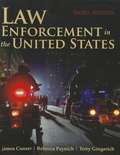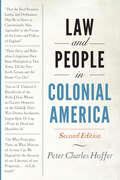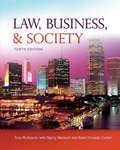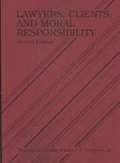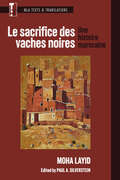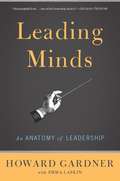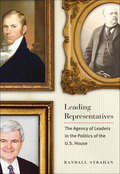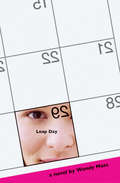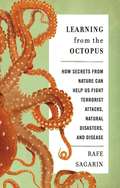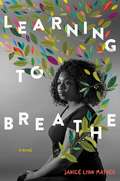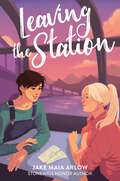- Table View
- List View
Law Enforcement in the United States
by James A. Conser Rebecca Paynich Terry E. GingerichThis book is an ideal introduction to law enforcement and goes beyond discussions of local policing to examine how forces like technology, privatization, and the threat of terrorism are affecting law enforcement on local, state, and national levels. Readers will learn how these diverse and unpredictable forces are shaping the future of law enforcement in the United States, and will come away with the ability to think critically about law enforcement issues. New Material added to the revised and updated Third Edition:-"Stay Current" boxes throughout the text offer references and key search terms for further internet research-Updated figures, tables, charts and other statistical and descriptive information-A New chapter on socialization, advancement, and professionalism, including ethics and misconduct-A New chapter with emphasis on law enforcement's role in national security, homeland security, and protecting private assets-A separate chapter on "Policing Strategies, Tactics, and Daily Operations"-An expanded and updated chapter on management issues-Updated and expanded appendices
Law and Ethics for the Health Professions (6th Edition)
by Karen Judson Carlene HarrisonLaw & Ethics for the Health Professions, sixth edition, provides an overview of the laws and ethics you should know to help you give competent, compassionate care to patients that is also within acceptable legal and ethical boundaries. The text can also serve as a guide to help you resolve the many legal and ethical questions you may reasonably expect to face as a student and, later, as a health care practitioner.
Law and People in Colonial America
by Peter Charles HofferAn essential, rigorous, and lively introduction to the beginnings of American law.How did American colonists transform British law into their own? What were the colonies' first legal institutions, and who served in them? And why did the early Americans develop a passion for litigation that continues to this day? In Law and People in Colonial America, Peter Charles Hoffer tells the story of early American law from its beginnings on the British mainland to its maturation during the crisis of the American Revolution. For the men and women of colonial America, Hoffer explains, law was a pervasive influence in everyday life. Because it was their law, the colonists continually adapted it to fit changing circumstances. They also developed a sense of legalism that influenced virtually all social, economic, and political relationships. This sense of intimacy with the law, Hoffer argues, assumed a transforming power in times of crisis. In the midst of a war for independence, American revolutionaries used their intimacy with the law to explain how their rebellion could be lawful, while legislators wrote republican constitutions that would endure for centuries.Today the role of law in American life is more pervasive than ever. And because our system of law involves a continuing dialogue between past and present, interpreting the meaning of precedent and of past legislation, the study of legal history is a vital part of every citizen's basic education. Taking advantage of rich new scholarship that goes beyond traditional approaches to view slavery as a fundamental cultural and social institution as well as an economic one, this second edition includes an extensive, entirely new chapter on colonial and revolutionary-era slave law. Law and People in Colonial America is a lively introduction to early American law. It makes for essential reading.
Law, Business and Society (Tenth Edition)
by Tony McadamsDon't Just Learn the Law, Learn the Law in Context! In the tenth edition of Law, Business, and Society, Tony McAdams discusses the role of the market, ethics/social responsibility, and the law in regulating the complex relationship between business and the larger society. McAdams examines whether the market and ethics/social responsibility have failed, and if government intervention is needed to maintain a healthy relationship between business practice and society's general welfare. The text serves as a general introduction to the legal system, including chapters on constitutional law, the common law of contracts and torts, and employment law. The closely written narrative, edited law cases, contemporary vignettes from daily life and an abundance of thought-provoking questions help convey key points. In addition, Law, Business, and Society precisely conforms to AACSB International accreditation expectations.
Law, Order, and Empire: Policing and Crime in Colonial Algeria, 1870–1954
by Samuel KalmanWhile much attention has focused on society, culture, and the military during the Algerian War of Independence, Law, Order, and Empire addresses a vital component of the empire that has been overlooked: policing. Samuel Kalman examines a critical component of the construction and maintenance of a racial state by settlers in Algeria from 1870 onward, in which Arabs and Berbers were subjected to an ongoing campaign of symbolic, structural, and physical violence. The French administration encouraged this construct by expropriating resources and territory, exploiting cheap labor, and monopolizing government, all through the use of force. Kalman provides a comprehensive overview of policing and crime in French Algeria, including the organizational challenges encountered by officers. Unlike the metropolitan variant, imperial policing was never a simple matter of law enforcement but instead engaged in the defense of racial hegemony and empire. Officers and gendarmes waged a constant struggle against escalating banditry, the assault and murder of settlers, and nationalist politics—anticolonial violence that rejected French rule. Thus, policing became synonymous with repression, and its brutal tactics foreshadowed the torture and murder used during the War of Independence. To understand the mechanics of empire, Kalman argues that it was the first line of defense for imperial hegemony. Law, Order, and Empire outlines not only how failings in policing were responsible for decolonization in Algeria but also how torture, massacres, and quotidian colonial violence—introduced from the very beginning of French policing in Algeria—created state-directed aggression from 1870 onward.
Lawyers, Clients and Moral Responsibility (2nd Edition)
by Robert F. Cochran Thomas L. ShafferThis second edition of the authors influential LAWYERS, CLIENTS, AND MORAL RESPONSIBILITY explores the place of moral and social values in the law office with the use of engaging stories, dialogues and discussion. The book presents a practical way for lawyers to raise and discuss moral issues with clients. It will serve as an engaging supplement to professional responsibility, client-counseling, and legal clinic courses. This second edition adds substantial discussion of the place of moral discourse within law firms and corporations, ways to engage the powerless client in moral discourse, and the place of social justice in client counseling.
Le sacrifice des vaches noires: Une histoire marocaine (MLA Texts and Translations #44)
by Moha LayidAn oasis community in Morocco hopes to stop a devastating drought by sacrificing black cows to satisfy the spirits. But the wise elder Bassou secretly plans a different solution: to sabotage the motorized pumps that have lowered the water table and nearly destroyed the subsistence farming and herding that support the local way of life. The young newlywed Yidir agrees to help him and eventually becomes a part of the broader fight for Moroccan independence from French colonial rule.Portraying an indigenous community undergoing radical change, Le sacrifice des vaches noires reflects on notions of modernity and tradition, science and spirituality, free will and fate, and considers the moral obligations of individuals and community. First published in French in 1992, the novel received international acclaim and is regarded as the single best work about Amazigh culture in southeastern Morocco. It was adapted into the award-winning film Atash (Thirst) by the Moroccan director Saâd Chraïbi in 2000.
Leadership: Research Findings, Practice, and Skills, Eighth Edition
by Andrew J. DubrinLeadership: Research Findings, Practice, and Skills, eighth edition is designed for undergraduate and graduate courses in leadership that give attention to research findings about leadership, leadership practice, and skill development. The text best fits courses in leadership that emphasize application and skill building. The new edition of this text is a thorough update of the seventh edition.
Leadership: Theory and Practice (Sixth Edition)
by Peter G. NorthouseThe main objective of this book is bridging the gap between the often-simplistic popular approaches to leadership and the more abstract theoretical approaches.
Leading Minds: An Anatomy Of Leadership
by Howard Gardner Emma LaskinPsychologist Howard Gardner, creator of the multiple intelligences framework and author of many books on the mind, explores the major facets of leadership from the perspective of psychology. In this work for general readers (first published in 1995), he presents a framework for understanding leadership and illustrates the framework with profiles of famous leaders such as anthropologist Margaret Mead, civil rights leader Martin Luther King, Jr. , Pope John XXIII, and Mahatma Gandhi. The book is illustrated with b&w historical photos of leaders. This edition contains a new preface by Gardner reviewing his reasons for writing the book, offering reflections on the past 15 years in leadership studies, and commenting on how leadership has changed in the era of "truthiness, twaddle, and Twitter. " Annotation ©2012 Book News, Inc. , Portland, OR (booknews. com)
Leading Representatives: The Agency of Leaders in the Politics of the U.S. House (Interpreting American Politics)
by Randall StrahanMany studies of Congress hold that congressional leaders are "agents" of their followers, ascertaining what legislators agree on and acting to advance those issues rather than stepping to the forefront to shape national policy or the institution they lead. Randall Strahan has long argued that this approach to understanding leadership is incomplete. Here he demonstrates why and explores the independent contributions leaders make in congressional politics.Leading Representatives is a study that draws on both historical and contemporary cases to show how leaders in the U.S. House have advanced changes inside Congress and in national policy. Exploring the tactics, tenure, and efficacy of the leadership of three of the most colorful and prominent Speakers of the House—Henry Clay, Thomas Reed, and Newt Gingrich—Strahan finds that these men, though separated in time and of differing thought and actions, were all leaders willing to take political risks to advance goals they cared about deeply. As a result, each acted independently of his followers to alter the political landscape. Strahan makes use of a wide range of resources, including the former representatives' papers and correspondence and interviews with Gingrich and his staffers, to demonstrate how these important leaders influenced policy and politics and where they ran aground.In expounding lessons Strahan has gleaned over two decades of studying U.S. legislative politics, Leading Representatives offers a new theoretical framework—the conditional agency perspective—that effectively links contextual perspectives as applied to congressional leadership with those emphasizing characteristics of individual leaders. This engagingly written book will be of interest to political scholars of all stripes as well as readers inclined to learn more about the history and inner workings of the House.
Leap Day (Little Brown Novels)
by Wendy MassSometimes Josie wonders what other people are thinking, and in this uniquely constructed novel, readers "leap" into the minds and viewpoints of Josie and everyone around her as she goes through her day. Josie learns that birthday surprises, play auditions, and the all-important initiation at the lake may be the things that define her today, but what defines her tomorrow and in the days to come are the people that touch her life at every moment. This fascinating and surprising novel, now in paperback, is full of everyday imaginations and truths in the life and future of one everygirl teenager.
Learning Cognitive-Behavior Therapy: An Illustrated Guide
by Michael E. Thase Jesse H. Wright Monica R. BascoLearning Cognitive-Behavior Therapy: An Illustrated Guide is designed to help both students and practitioners master the core methods of this proven form of psychotherapy. This easy-to-use guidebook offers full explanations of the most effective behavioral methods; a program designed for achieving competency that covers both basic methods for patients with depression and anxiety and advanced techniques for patients with bipolar disorder, psychoses, and eating and personality disorders; an integrated cognitive-behavioral/biological/interpersonal model for treatment; and instructions on fully integrating CBT with psychopharmacological intervention, as well as formulation and treatment methods endorsed by the Academy of Cognitive Therapy.
Learning Disabilities and Related Disorders: Characteristics and Teaching Strategies
by Janet W. Lerner Frank KlineDesigned to help pre-service teachers and practicing professionals evaluate and aid students with disabilities, this comprehensive text is guided by three main principles: to aid in the assessment and evaluation of students with learning disabilities, to demonstrate Learning Disabled (LD) theory and its practical applications through the use of case studies, and to provide the most up-to-date information on recent developments and topics of debate in the field. The Tenth Edition continues to stress familiarity with state and national standards, specifically those from the Council for Exceptional Children (CEC).
Learning From the Octopus: How Secrets from Nature Can Help Us Fight Terrorist Attacks, Natural Disasters, and Disease
by Rafe SagarinDespite the billions of dollars we've poured into foreign wars, homeland security, and disaster response, we are fundamentally no better prepared for the next terrorist attack or unprecedented flood than we were in 2001. Our response to catastrophe remains unchanged: add another step to airport security, another meter to the levee wall. This approach has proved totally ineffective: reacting to past threats and trying to predict future risks will only waste resources in our increasingly unpredictable world. In Learning from the Octopus, ecologist and security expert Rafe Sagarin rethinks the seemingly intractable problem of security by drawing inspiration from a surprising source: nature. Biological organisms have been living--and thriving--on a risk-filled planet for billions of years. Remarkably, they have done it without planning, predicting, or trying to perfect their responses to complex threats. Rather, they simply adapt to solve the challenges they continually face. Military leaders, public health officials, and business professionals would all like to be more adaptable, but few have figured out how. Sagarinargues that we can learn from observing how nature is organized, how organisms learn, how they create partnerships, and how life continually diversifies on this unpredictable planet. As soon as we dip our toes into a cold Pacific tidepool and watch what we thought was a rock turn into an octopus, jetting away in a cloud of ink, we can begin to see the how human adaptability can mimic natural adaptation. The same mechanisms that enabled the octopus's escape also allow our immune system to ward off new infectious diseases, helped soldiers in Iraq to recognize the threat of IEDs, and aided Google in developing faster ways to detect flu outbreaks. While we will never be able to predict the next earthquake, terrorist attack, or market fluctuation, nature can guide us in developing security systems that are not purely reactive but proactive, holistic, and adaptable. From the tidepools of Monterey to the mountains of Kazakhstan, Sagarin takes us on an eye-opening tour of the security challenges we face, and shows us how we might learn to respond more effectively to the unknown threats lurking in our future.
Learning The Art of Helping: Building Blocks and Techniques (5th Edition)
by Mark E. YoungThis best-selling resource is a great refresher and hands-on resource for counselors new to their professions. It's packed with step-by-step guidance for developing the skills and techniques they need to effectively help their clients. It covers not just the basic building blocks in the profession, but also what the author calls the "megaskills" and common curative factors that lie behind the methods. The tone is conversational and the references are very useful.
Learning to Breathe: A Novel
by Janice Lynn MatherA 2019 YALSA Best Fiction for Young Adults Selection Amelia Bloomer List&’s 2019 Top Ten Recommended Feminist Books for Young Readers A Governor General&’s Literary Award Finalist A Junior Library Guild Selection A Sheila A. Egoff Children&’s Literature Prize Semifinalist A BC Book Prize Finalist &“A love letter to girls—bittersweet and full of hope.&” —Ibi Zoboi, author of National Book Award Finalist American Street &“This is a stellar debut.&” —Brandy Colbert, award-winning author of Little & Lion and Pointe &“A vibrant, essential story of healing, resilience, and finding one&’s family.&” —Stephanie Kuehn, author of William C. Morris Award winning Charm & Strange &“A raw, beautiful, unforgettable must-read.&” —Tiffany D. Jackson, author of Allegedly &“Poetic.&” —Angela Johnson, award-winning author of Heaven &“A powerful, poignant story about refusing to let the past dictate who you are or who you will become.&” —Kirkus Reviews &“This is a well-written, thought-provoking book that tackles difficult topics…a stirring debut.&” —School Library Journal (starred review) Sixteen-year-old Indy struggles to conceal her pregnancy while searching for a place to belong in this stunning debut novel that&’s perfect for fans of Amber Smith and Sara Zarr.Indira Ferguson has done her best to live by her Grammy&’s rules—study hard in school, be respectful, and never let a boy take advantage of her. But it hasn&’t always been easy, especially living in her mother&’s shadow. When Indy is sent to stay in Nassau, trouble follows her and she must hide an unwanted pregnancy from her aunt, who would rather throw Indy out onto the street than see the truth. Completely broke with only a hand-me-down pregnancy book as a resource, Indy desperately looks for a safe space to call home. After stumbling upon a yoga retreat, she wonders if she&’s found that place. But Indy is about to discover that home is much bigger than just four walls and a roof—it&’s about the people she chooses to share it with.
Learning to Read Critically in Teaching and Learning (Learning to Read Critically series)
by Mike Wallace Louise Poulson`Learning to Read Critically in Teaching and Learning offers a contribution to the debates on curriculum and pedagogy. The title itself is especially noteworthy since it indicates quite clearly that the reader is being encouraged both to learn and to develop their critical faculties on the topic of teaching and learning. This is a clever multi-layering of meaning that reflects the aims of the book extremely well′ - School Leadership & Management This book combines a teaching text with exemplary reports of research and a literature review by international scholars. Part One offers ideas on: how to become a critical reader and self-critical writer of literature; how to apply these insights in planning a written assignment, dissertation or thesis. The student is provided with a framework for the critical analysis of any text and shown how to incorporate it in a literature review. Part Two presents accounts of leading-edge research from well-known contributors, offering insights into key issues in the field of teaching and learning. These accounts reflect diverse theoretical approaches, national contexts, topics, research designs, methods of data collection and analysis, and styles of reporting. The student is invited to practice literature review skills by applying the critical analysis questions to any research report. Part Three is a critical literature review of a substantive issue in teaching and learning. It shows how a high-quality literature review may be constructed and addresses key issues in the field. This book is essential for students on research-based masters and doctorate courses in teaching and learning; and for students undertaking research training in the humanities and social sciences. This series, edited by Mike Wallace, supports research-based teaching on masters and taught doctorate courses in the humanities and social sciences fields of enquiry. Each book is a ′three in one′ text designed to assist advanced course tutors and dissertation supervisors with key research-based teaching tasks and aims to: • develop students′ critical understanding of research literature • increase students′ appreciation of what can be achieved in small-scale investigations similar to those which they undertake for their dissertation • present students with major findings, generalisations and concepts connected to their particular field.
Leaving the Station
by Jake Maia ArlowNina LaCour meets Alyson Derrick in this cross-country journey of identity, love, and friendships as Zoe tries to figure out her life, one train stop at a time.Zoe’s life has gone off the rails.When she left Seattle to go to college in New York, she was determined to start fresh, to figure out what being a lesbian meant to her, to experiment with clothes and presentation away from home for the first time. Instead, she lost touch with her freshman orientation friend group, skipped classes, and failed completely at being the studious premed student her parents wanted her to be. But the biggest derailment of all? Her newly minted ex-boyfriend—and the fact that she had a boyfriend to begin with. When she met Alden, he made her feel wanted, he made her feel free. He made her feel . . . like she could be like him, which was exciting and confusing all at once.So, Zoe decides a second fresh start is in order: She’s going to take a cross-country train from New York to Seattle for fall break. There, no one will know who she is, and she can outrun her mistakes.Or so she thinks until she meets Oakley, who’s the opposite of Zoe in so many ways: effortlessly cool and hot, smart, self-assured. But as Zoe and Oakley make their way across the country, Zoe realizes that Oakley’s life has also gone off the rails—and that they might just be able to help each other along before that train finally leaves the station.
Legacy of Light (The Effigies #3)
by Sarah RaughleyThe Effigies must uncover the connection between Saul, Blackwell, and the Phantoms before it&’s too late in this epic conclusion to the Effigies trilogy.The world is in chaos. After Saul&’s strike on Oslo—one seemingly led by Maia herself—the Effigies&’ reputation is in shambles. Now they&’re being hunted by nations across the globe, grouped in with the very terrorists they&’ve been trying to stop. With Maia&’s resurrected twin, June, carrying out vicious attacks across the world, everyone believes Maia is a killer. Belle has gone rogue, Chae Rin and Lake have disappeared, and the Sect is being dismantled and replaced by a terrifying new world order helmed by Blackwell. As for Saul, his ultimate plan still remains a mystery. And Maia? No one has seen or heard from her in weeks. It&’s all somehow connected—Saul, Phantoms, the Effigies, everything. But if the Effigies can&’t put the pieces together soon, there may not be much left of the world they&’ve fought so desperately to save.
Legal Aspects Of Special Education
by Kurt E. HulettFor every course in Special Education Law and Education Law, or as a perfect supplement to any Educational Administration course, Legal Aspects of Special Education was written by a practitioner to help teachers, administrators, and advocates understand special education law in everyday language- without excessive legalese or extraneous case law. Different in many ways from other special education law texts on the market, all of the elements of this text are intended to help its students obtain the most critical information about special education law and how it is applied in the real world. Some unique features include: a fascinating opening interview and then epilogue with Joe Ballard, a pioneer of the IDEA movement; a discussion of Response-to-Intervention (RTI) and the implication of IDEA 2004 for school districts; and a discussion of the history of special education and its link to the Civil Rights Movement. Additionally, the book provides case studies and application questions, critical thinking questions, the most current information on the laws including No Child Left Behind and the Individuals with Disabilities Education Act of 2004, and a discussion of major trends changing the laws, including that of autism.
Legal Office: Concepts and Procedures
by Robert CumminsThis textbook-workbook is divided into three parts with seventeen chapters to provide the legal office assistant student with a logical frame of reference in the study of the basic concepts of the law.
Legal Research, Analysis, And Writing
by William H. Putman Jennifer R. AlbrightComprehensive yet easy to understand, the third edition of LEGAL RESEARCH, ANALYSIS, AND WRITING teaches the fundamentals in a hands-on, step-by-step format that is designed to build confidence. With coverage of key topics such as research analytical principles, legal research, legal analysis, and legal writing, this popular book covers the information readers need to know in order to find, access, apply, and analyze legal materials. Numerous hypotheticals, examples, and exercises clarify material and give readers additional opportunities for practice. In addition, the third edition includes the most up-to-date information in the field, with special attention given to electronic research programs such as WestlawNext, LexisNexis interface, Shepard's online, and Westlaw's KeyCite.
Legal Writing (2nd Edition)
by Sheila J. Simon Richard K. Neumann Jr.Written for law students, this well-organized and thorough book shows how to hone legal writing skills in real-world situations. Topics include process, style, memoranda writing, organizing analysis (CREAC), analytical writing, persuasive writing, telling a client's story, making the client's argument, appellate briefs, and oral argument. Each chapter includes exercises. Appendices contain sample memos and briefs. An accompanying access code protected website offers supplementary material including videos, checklists, and articles. Annotation ©2011 Book News, Inc. , Portland, OR (booknews. com)
Legend of the White Snake
by Sher LeeA snake spirit transforms into a boy and must hide his true identity after falling for a headstrong prince in this lush, romantic retelling of the traditional Chinese folktale. When Prince Xian was a boy, a white snake bit his mother and condemned her to a slow, painful death. The only known cure is an elusive spirit pearl—or an antidote created from the rare white snake itself. Desperate and determined, Xian travels to the city of Changle, where an oracle predicted he would find and capture a white snake.Seven years ago, Zhen, a white snake in the West Lake, consumed a coveted spirit pearl, which gave him special powers—including the ability to change into human form.In Changle, Xian encounters an enigmatic but beautiful stable boy named Zhen. The two are immediately drawn to each other, but Zhen soon realizes that he is the white snake Xian is hunting. As their feelings grow deeper, will the truth about Zhen’s identity tear them apart?
